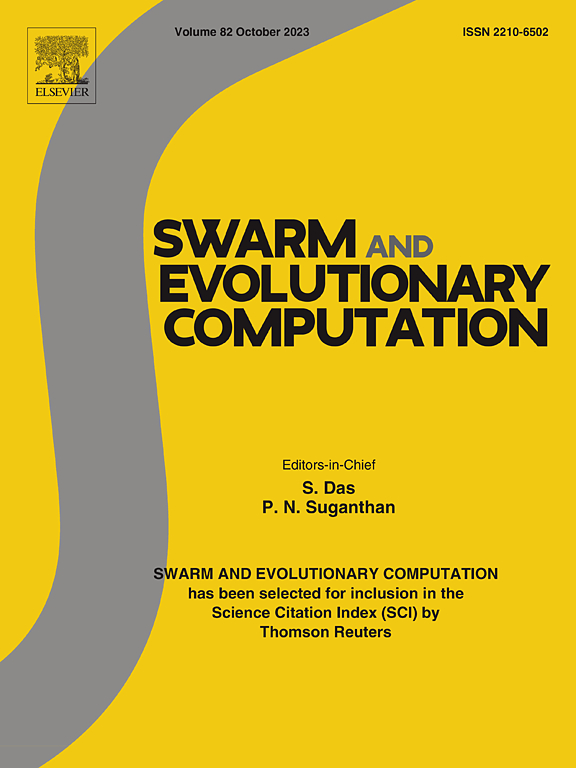An enhanced LSHADE-based algorithm for global and constrained optimization in applied mechanics and power flow problems
IF 8.5
1区 计算机科学
Q1 COMPUTER SCIENCE, ARTIFICIAL INTELLIGENCE
引用次数: 0
Abstract
This study proposes a new evolutionary algorithm, namely NL-SHADE, that combines the linear population size reduction-based SHADE (L-SHADE) with the Nutcracker Optimization Algorithm (NOA) to better solve global optimization and real-world constrained optimization problems. Several optimization algorithms have been developed in the literature to address these issues. However, they still stall in local optima and exhibit slow convergence speed, which are the main limitations that motivate us to propose the NL-SHADE algorithm. In this algorithm, the SHADE algorithm is responsible for the exploration operator in the early stages of the optimization process to avoid stagnation in local optima, while NOA is responsible for improving convergence speed. Furthermore, at the end of each generation, the linear population size reduction method is used to exclude some inferior solutions that might lead to local optima and reduce convergence speed. To solve the constrained optimization problems, NL-SHADE is combined with a gradient-based repair method to propose a new variant, rNL-SHADE, which uses gradient information from the constraint set to direct infeasible solutions into feasible regions. In this study, two experiments are conducted. In the first experiment, the proposed NL-SHADE is evaluated using two unconstrained CEC benchmarks, CEC2017 and CEC2020, and compared with numerous cutting-edge algorithms using several performance metrics. In the second experiment, the performance of the proposed algorithms is also tested by solving 29 RWC optimization problems from four different domains. The experimental findings demonstrate that, for the majority of the solved RWC problems, rNL-SHADE can perform better than all compared algorithms.
应用力学和潮流问题的全局约束优化改进lshade算法
本研究提出了一种新的进化算法NL-SHADE,将基于线性种群大小缩减的SHADE (L-SHADE)算法与胡桃夹子优化算法(NOA)相结合,以更好地解决全局优化和现实世界的约束优化问题。在文献中已经开发了几种优化算法来解决这些问题。然而,它们仍然停留在局部最优,收敛速度慢,这是促使我们提出NL-SHADE算法的主要限制。在该算法中,SHADE算法负责优化过程早期的勘探算子,避免停滞于局部最优,而NOA算法负责提高收敛速度。此外,在每一代结束时,采用线性种群大小缩减方法,排除可能导致局部最优,降低收敛速度的劣等解。为了解决约束优化问题,将NL-SHADE与基于梯度的修复方法相结合,提出了一种新的变体rNL-SHADE,它利用约束集的梯度信息将不可行解引导到可行区域。在本研究中,进行了两个实验。在第一个实验中,使用两个无约束CEC基准(CEC2017和CEC2020)对所提出的NL-SHADE进行了评估,并使用几个性能指标与众多尖端算法进行了比较。在第二个实验中,通过解决来自四个不同领域的29个RWC优化问题来测试所提出算法的性能。实验结果表明,对于大多数已解决的RWC问题,rNL-SHADE的性能优于所有比较算法。
本文章由计算机程序翻译,如有差异,请以英文原文为准。
求助全文
约1分钟内获得全文
求助全文
来源期刊

Swarm and Evolutionary Computation
COMPUTER SCIENCE, ARTIFICIAL INTELLIGENCEC-COMPUTER SCIENCE, THEORY & METHODS
CiteScore
16.00
自引率
12.00%
发文量
169
期刊介绍:
Swarm and Evolutionary Computation is a pioneering peer-reviewed journal focused on the latest research and advancements in nature-inspired intelligent computation using swarm and evolutionary algorithms. It covers theoretical, experimental, and practical aspects of these paradigms and their hybrids, promoting interdisciplinary research. The journal prioritizes the publication of high-quality, original articles that push the boundaries of evolutionary computation and swarm intelligence. Additionally, it welcomes survey papers on current topics and novel applications. Topics of interest include but are not limited to: Genetic Algorithms, and Genetic Programming, Evolution Strategies, and Evolutionary Programming, Differential Evolution, Artificial Immune Systems, Particle Swarms, Ant Colony, Bacterial Foraging, Artificial Bees, Fireflies Algorithm, Harmony Search, Artificial Life, Digital Organisms, Estimation of Distribution Algorithms, Stochastic Diffusion Search, Quantum Computing, Nano Computing, Membrane Computing, Human-centric Computing, Hybridization of Algorithms, Memetic Computing, Autonomic Computing, Self-organizing systems, Combinatorial, Discrete, Binary, Constrained, Multi-objective, Multi-modal, Dynamic, and Large-scale Optimization.
 求助内容:
求助内容: 应助结果提醒方式:
应助结果提醒方式:


